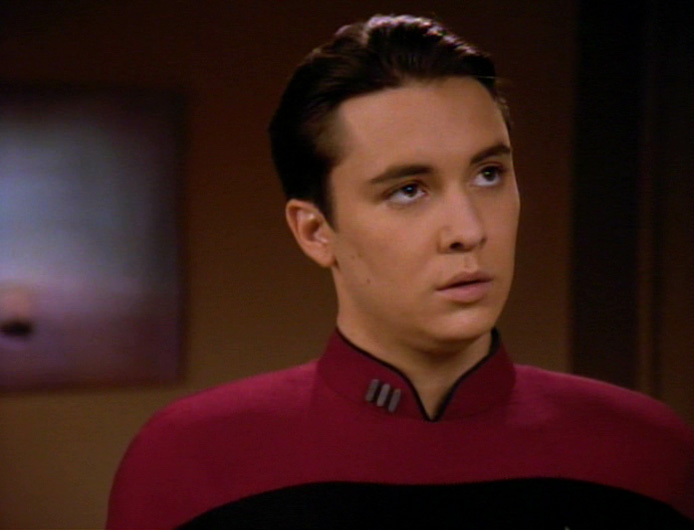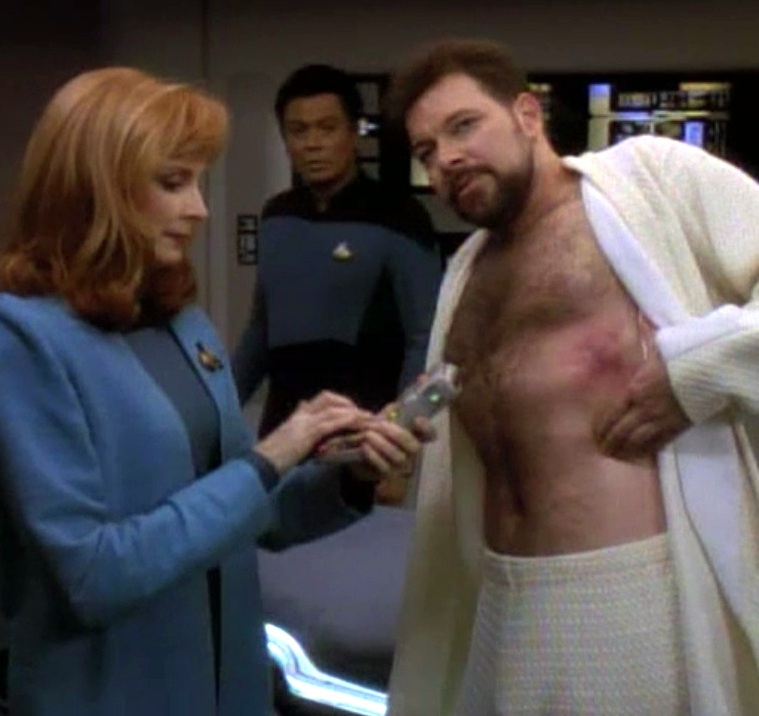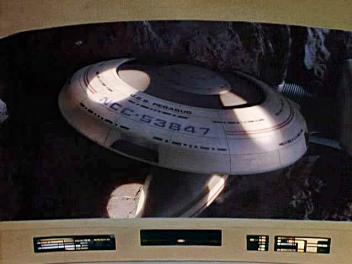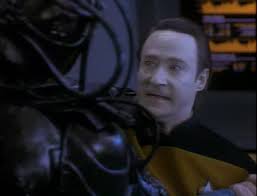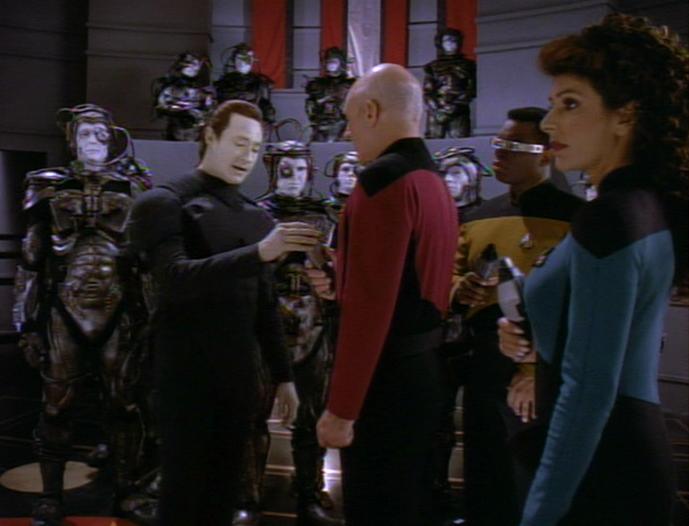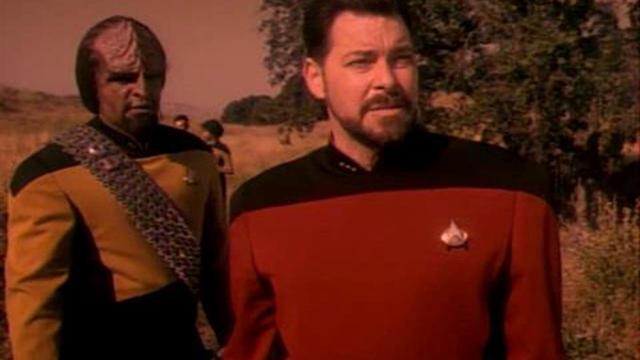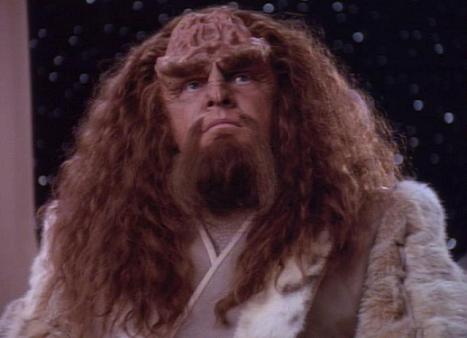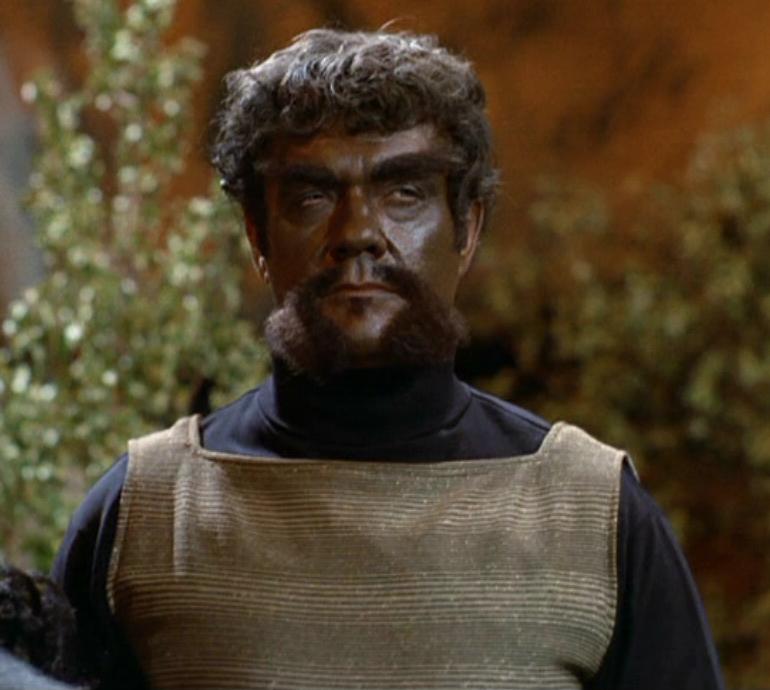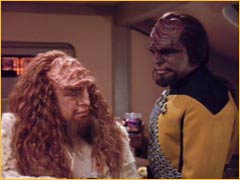
Retired Kirk, helping christen the new Enterprise-B, is believed killed when a mysterious energy ribbon slams the side of the ship during an unplanned rescue mission. Seventy-eight years later, Picard and Co. must investigate a Romulan attack on a science outpost where one of the survivors of the Enterprise-B rescue, Tolian Soran (Malcolm McDowell) now works. Soran then destroys a nearby star, kidnaps Geordi — thanks to Data’s cowering after installing his emotion chip — and takes off in a Bird of Prey with the Duras sisters (from “Redemption”). Picard and Data figure out Soran’s destroying stars so he can change space stuff and bring the energy ribbon to a planet where it can take him away from it all. The energy ribbon is actually the Nexus, a half-baked trope where “time has no meaning” or something. Soran wants to use it to be reunited with his family, killed by the Borg (Soran’s the same species as Guinan). Picard fails in a one-on-one attempt to stop Soran, but he’s swept into the Nexus, where he finds Kirk. The two go back in time and stop Soran, though Kirk is killed in the fracas (more on that in a moment). Meanwhile, Riker does a really lousy job in the big chair (more on that in a moment, too) and lets the Duras sisters destroy the ship’s star drive, forcing the saucer to crash on the planet. No one’s killed, but the Enterprise-D is wrecked beyond repair, and Picard and Riker beam aboard rescue ships hinting that another Enterprise could be coming soon. James Bond will also be back in ‘Thunderball’ …

Why it’s important
Let’s say a random main character from one of the many Trek series got killed — let’s pick Tom Paris from Voyager. That, alone, wouldn’t merit a review by this site’s guidelines, even though Paris was a pretty decent character and (probably) had a lot of fans. But James T. Kirk is James T. freaking Kirk. He’s a dude who led the Enterprise crew in saving Earth twice, his 5-year mission as captain of the Enterprise was one of Starfleet’s most historic, he can outsmart any supercomputer around and he can change the fate of parallel universes with a really good speech. His death is part of the Trek Tapestry. He’s James T. freaking Kirk.
It’s also pretty significant when an Enterprise (or a Defiant, or even a Voyager) gets destroyed. More on just how ridiculous the destruction was in a moment, as promised.
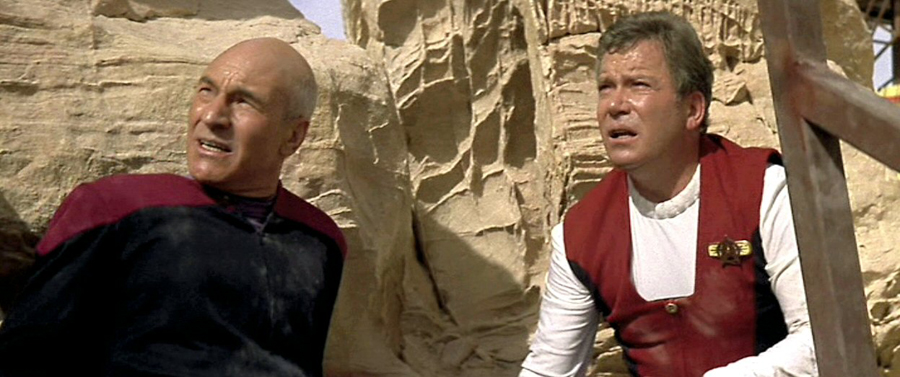
What doesn’t hold up
Get comfortable, people. Because this might be our rantiest review.
First of all, the creators fell back on the trope from the TOS movies that the Enterprise (or the Enterprise crew) is the only entity able to intervene in a crisis. We saw this in four of the first six movies, with varying degrees of plausibility. The idea here that the new Enterprise-B, on a training mission in Earth’s solar system, is “the only ship in range” is laughable — maybe more so than the previous instances. It would mean that Starfleet has no warp-capable ships in the Terran System, home to Starfleet headquarters and Starfleet Academy. Otherwise, one of them would have been “in range” to respond.
Also, it’s weird that the Enterprise-D looks so different since “All Good Things … “. Some of the changes are improvements, but there’s no dialog about a refit and it doesn’t seem like THAT much time has passed. Also, the use of normal uniforms along with DS9 jumpsuits was kind of strange, but forgivable. Less so is the weird new look Data’s emotion chip has (it’s grown since “Descent”). But whatevs. If we can be cool with Data’s cat apparently getting a sex change …
Now, there is the strange matter of Kirk and Antonia in the weird quasi-reality of the Nexus. Kirk indicates that he went back to Starfleet shortly after the events we sort of see here — which Kirk says occurred nine years earlier. The Enterprise-B launched in 2293 — less than a year after the events of “Star Trek VI: The Undiscovered Country” — so that would mean Kirk makes Antonia Ktarrian eggs in 2284. But that doesn’t make much sense because the events of “Star Trek II: The Wrath of Khan” occur around that time.
Are we to believe Kirk went back to Starfleet (essentially ending things with Antonia, despite the eggs) and had enough time to get bored and do the soul-searching that we see in the early parts of “Wrath of Khan”? I suppose it’s possible — but the creators could have saved themselves a LOT of trouble if they had simply made the whole Antonia thing occur closer to the date of “Star Trek: The Motion Picture” — there were 14 years between the events of the first and second movies — or in the six years between “Star Trek V: The Final Frontier” and “Star Trek VI: The Undiscovered Country”. The second option would have been a good choice, because Kirk’s appearance, uniform, etc., could have been about the same. In other words, they wouldn’t have had to explain why 2293 Kirk didn’t look like 2285 Kirk (or 2277 Kirk).
The whole thing was poorly done considering we’ve never heard of Antonia before and that the creators didn’t need to include the whole “going back to Starfleet” thing. Antonia — or a more appropriate lost love, like Carol Marcus — could have been lost in a way that didn’t take a giant dump on Kirk’s backstory.
Oh, and considering that Scotty believed Kirk died in the movie’s opening moments, why did he ask if Kirk had come to rescue him when he’s discovered in “Relics” during TNG’s sixth season? I suppose you could argue that Scotty was hopeful that Kirk would be found or (and this is a stretch) that the slight degradation of his transporter pattern mentioned in “Relics” included his memory of Kirk’s apparent death. But, really, the answer likely is that Leonard Nimoy and DeForest Kelley weren’t down for the minimal roles as Kirk’s companions on the Enterprise-B, so James Doohan and Walter Koenig got the call. Why else would Chekov suddenly know all about medical stuff?
Now, let’s talk about the Nexus. Apparently, Soran does everything he does because he’s desperate to get back to it — and he can’t get there in a ship. But, of course, our boy Jimbo was on a ship when he got swept into the Nexus and Soran was (briefly) in the Nexus and got there when he was on a ship (so was Guinan). Of all the dumb points of this movie, this is the one that could have easily been explained. A simple line about how being on a planet was a surer bet to successfully get into the Nexus would have covered it. Maybe Soran was simply shoring up his chances.
Then, there’s the whole matter of what it’s all about to BE in the Nexus. At times, it’s written as a sort of super-holodeck, where nothing is real and your greatest fantasies can come true. Picard’s fake family is proof of that and he uses the fact that the Nexus isn’t real in his attempt to recruit Kirk. Kirk learns the hard way that the Nexus isn’t real when he makes a jump with his horse and feels no fear — fear he would have felt had the jump been made in real life.
So, the Nexus allows you to recreate your past or create something completely new — again, like a super holodeck. And that’s all well and good, as far as it goes.
But then, Picard and Kirk stop using it as a holodeck. It becomes, essentially, a time portal that our heroes use to go back to a few minutes before Soran launches his rocket, figuring two against one will yield a different result (which it does). What I can’t figure out is why this use of the Nexus deposits Picard and Kirk in the “real” world near Soran’s launcher while Kirk was in a fake world when he was back with Antonia.
If the Nexus allows time travel, then Kirk should have been in the real world with Antonia (Picard’s situation is somewhat different, because he doesn’t actually go back and relive events that truly happened). But here’s the thing — if the Nexus works like a holodeck, then Kirk and Picard didn’t really stop Soran. They only thought they did in some sort of dreamworld, and Picard goes on living in that dreamworld and Kirk DIES in the dreamworld! And if the Nexus truly allows for time travel, then Kirk should have been back with Antonia in the real world. What’s really sad is that there was a better way to handle all of this — and it starts with making the Nexus a time portal and not a super holodeck. Here’s how …
After they enter the Nexus, Picard and Kirk could have really gone back in time to some point that they each longed for (which Kirk actually does). This would remove all the Picard family nonsense, which was really poorly done and much too cloying, anyway.
Maybe Picard could have gotten his wish to be back with Miranda Vigo (or another lost love) but realized (while he still has access to the Nexus time-travel stuff) that he needed to leave to save the people on Verdian IV. The drama would have been whether Picard is capable of making such a sacrifice — and it would have been compelling, particularly since he learns his brother and nephew died at the beginning of the film. He would have to pick duty over everything else.
To bring Kirk into the equation, Picard would have to somehow learn that Kirk was also taken back in time by the Nexus. Picard would have had to figure that Kirk, like him, would sacrifice his own happiness for the lives of millions of people. Picard would then find Kirk, ask him to come with him and then, the two could have stopped Soran.
To be sure, a lot of details would have to be figured out. But removing the “isn’t real” aspect of the Nexus would have made the movie MUCH more dramatic because Kirk and Picard would have had to make REAL sacrifices instead of just shrugging off weird fake versions of their lives. In the scenario I’ve outlined, the sacrifice is greater — and the willingness of both of them to make the sacrifice as a matter of duty would have been a more interesting connection. Both guys who were smarting over a lack of family would have had to pass up REAL families and not just some fake versions.
There’s also the whole matter of the Guinan “echo.” Guinan met Picard in the 19th century (in “Times Arrow”) so the 23rd century version who was briefly in the Nexus would know who he is. But would 23rd century Guinan know enough to give Picard the crucial info he needs to recruit Kirk? I can buy an echo of Guinan in the Nexus — beats hanging on the set of “The View” — but how does she know what she knows? Do we just chalk it up to Guinan-ness?
Last point about the Nexus: Even if we could reconcile the Nexus as some sort of super time-traveling creation/super holodeck, why did Picard choose to go back to a point when he and Kirk would have such a difficult time stopping Soran? Why not simply go back to Ten Forward when he met Soran and have Data and Geordi help escort Soran to the brig? Clearly, that negates the need for Kirk, but still. I bet poor Geordi would have liked Picard thinking of a way to keep him from getting tortured by Soran and the Klingons.
As for Kirk’s noble sacrifice, it really falls pretty flat (no pun intended). So, the main hero of Star Trek dies because he needs to jump for a control pad on a creaky bridge? It’s really weak sauce. His “original” death saving the Enterprise-B was way, way, way more appropriate. And the unreleased death (where Soran shoots him in the back) might have been better, too. It sure would have made Picard burying him at the top of a peak more believable, considering where Picard found Kirk (in a ravine) in the version that was actually released.
Now, let’s talk about the destruction of the Enterprise-D …
Before Soran and the Klingons return Geordi (in exchange for Picard, or something), Soran lets the Duras sisters see everything Geordi sees through his VISOR. Why they can see normally has always made me pause — shouldn’t they see something more akin to what we saw way back in “Heart of Glory” or “The Mind’s Eye”? — but whatever. I’ll grant the movie that detail.
Geordi eventually heads to engineering, where the Duras sisters get a glimpse of a panel that shows the Enterprise’s shield frequency. They tune their torpedoes to said frequency and start blasting through the shields. Now, sure, maybe they get a couple shots in before Riker and Co. figure out what’s happening — and maybe things would have made sense if one of the first shots caused a core breach or took out a nacelle or something.
But Riker, Worf, Geordi and Data just act like morons over the next few minutes. These are the dudes who took down a Borg cube and dealt with shield modulation for eight hellish days — in which it looked like the Federation might be reduced to nanites. You’d think modulating the shields would be like their go-to freaking move.
But what do they do when Lursa and B’Etor find a way to penetrate their shields but not damage the ship enough to where it’s a huge problem immediately? Almost nothing. They don’t remodulate the shields. They don’t head directly to the sisters’ ship and fire all weapons at a vessel that shouldn’t be any sort of match for the Federation flagship (shields or no). And they don’t warp out of orbit, with plans to return once they figured out what was going on.
Instead, Riker, Data, Geordi and Worf let the ship get pounded for several minutes while they come up with a way to trigger the Bird of Prey’s cloaking device and then fire at it with its shields down. Maybe this would have been an OK idea if — while Data was doing his thing — Worf and Riker had just started pounding the Bird of Prey or warped away for a few minutes. But to let the Enterprise continue to get pummeled? WTF, Will? Maybe Commander Shelby was right about you all along.
Of course, the last Klingon torpedo triggers a (slow-moving) warp-core breach, everyone’s evacuated to the saucer and the force of the explosion sends the saucer careening toward the planet. The saucer lands — in a cool visual scene, FWIW — but the events leading up to it are just stupid. Riker should have been drummed out of Starfleet for his performance in this movie and Worf and Data with him. Maybe Geordi, too.
There are countless ways in which the Duras sisters could have destroyed the Enterprise in a plausible manner. In addition to making their first shot more catastrophic, maybe they had procured a more powerful Klingon vessel (like Gowron’s from TNG) instead of their creaky Bird of Prey. At least then the shield thingy and the more powerful weapons could have realistically destroyed the Enterprise. There were still things Riker could have done, but his options would have been more limited.
Lastly, does anyone else ever cringe when Kirk and Picard talk about retirement? Picard is about 65 years old in 2371 and Kirk was about 60 in 2293. So, Kirk is talking about being put out to pasture to a dude who fights Romulans, Borg and Son’a well into his 70s. I guess Starfleet was cooler with older captains in the 24th century.
Final thoughts
Oh, “Generations”. I don’t think there’s ever been a Star Trek movie that had such high expectations. It was released when the franchise was arguably at its peak — but it really didn’t get the job done. There are way too many logical gaffes and the Enterprise-B captain (Cameron from “Ferris Bueller’s Day Off”) is just one of the worst plot crutches that I can think of — even if the opening scenes on the Enterprise-B are the strongest in the film.
Beyond that, the central concept of the movie — the Nexus — is just too flimsy and ridiculous. I think “Generations” is better than some of the other films — “Insurrection,” “Nemesis”, and “Final Frontier — but it is probably the most disappointing of the Trek movies.
Coming later this week …
The TNG cast and creators prove they can make a good movie.

